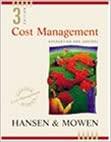John Thomas, vice president of Mallett Company (a producer of a variety of plastic prod ucts), has
Question:
John Thomas, vice president of Mallett Company (a producer of a variety of plastic prod¬
ucts), has been supervising the implementation of an activity-based cost management sys¬
tem. One of John's objectives is to improve process efficiency by improving the activities that define the processes. To illustrate the potential of the new system to the president, John has decided to focus on two processes: production and customer service.
Within each process, one activity will be selected for improvement: material usage for production and sustaining engineering for customer service. (Sustaining engineers are re¬
sponsible for redesigning products based on customer needs and feedback.) Value-added standards are identified for each activity. For material usage, the value-added standard calls for 6 pounds per unit of output. (Although the plastic products differ in shape and func¬
tion, their size, as measured by weight, is uniform.) The value-added standard is based on the elimination of all waste due to defective molds. The standard price of materials is $5 per pound. For sustaining engineering, the standard is 58% of current practical activity capac¬
ity. This standard is based on the fact that about 42% of the complaints have to do with de¬
sign features that could have been avoided or anticipated by the company.
Current practical capacity (at the end of 2000) is defined by the following requirements:
6,000 engineering hours for each product group that has been on the market or in develop¬
ment for 5 years or less, and 2,400 hours per product group of more than 5 years. Four prod¬
uct groups have less than 5 years' experience and 10 product groups have more. There are 24 engineers, each paid a salary of $60,000. Each engineer can provide 2,000 hours of ser¬
vice per year. There are no other significant costs for the engineering activity.
Actual material usage for 2000 was 25% above the level called for by the value-added standard; engineering usage was 46,000 hours. There were 80,000 units of output produced.
John and the operational managers have selected some improvement measures that promise to reduce nonvalue-added activity usage by 40% in 2001. Selected actual results achieved for 2001 are as follows:

The actual prices paid for materials and engineering hours are identical to the standard or budgeted prices.
Required:
1. For 2000, calculate the ncmvalue-added usage and costs for material usage and sus¬
taining engineering. Also, calculate the cost of unused capacity for the engineering activity.
2. Using the targeted reduction, establish kaizen standards for materials and engineering (for 2001).
3. Using the kaizen standards prepared in Requirement 2, compute the 2001 usage vari¬
ances, expressed in both physical and financial measures, for materials and engineer¬
ing. (For engineering, explain why it is necessary to compare actual resource usage with the kaizen standard.) Comment on the company's ability to achieve its targeted reduc¬
tions. In particular, discuss what measures the company must take to capture any re¬
alized reductions in resource usage.
Step by Step Answer:

Cost Management Accounting And Control
ISBN: 9780324002324
3rd Edition
Authors: Don R. Hansen, Maryanne M. Mowen





